[Gallery]
Gary James Joynes — A Review of Visual Sound in Practice
Gary James Joynes (aka Clinker) is an award-winning sound and visual artist who has been active in the international electronic and experimental music performance community for years. He has more recently embarked on a broader artistic exploration using his analogue synthesizers and custom made machines to create “visual-sound” as photograph / drawing / sculpture hybrids along with immersive and unending installation environments. Recent performances and exhibitions include MUTEK_IMG (Montréal), SoundsLike Audio Art Festival (Saskatoon), Sublimated Landscape / Sonic Topology @ ICA London (UK), Art Gallery of Alberta (Edmonton), Koffler Centre (Toronto), Electric Fields (Ottawa), Mountain Computer Music Festival (Montana), Roulette Mixology Festival (New York), Soundasaurus (Calgary), MUTEK_10 (Montréal) and The Banff Centre. The last few years have also seen his interest in experimental music and adventurous sound works extended into analogue noise performance as WIND ROSE (solo) and the collaborative projects Vipers WITHOUT Vapours (with Scott Smallwood) and Vector Rails (with Adam Tindale).
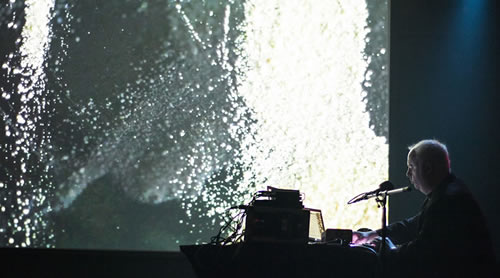
The artistic works of Gary James Joynes (also known under the moniker Clinker) are built on a foundation of experiments with the constructed patterns made by pushing high-energy resonant tones at specific frequencies through particulate matter — a phenomenon discovered by Ernst Chladni in the 18th century and documented and defined more fully as the science of Cymatics by Hans Jenny in the 1960s. Joynes, aware of other artists cymatic-based works using non-newtonian liquids, magnetic fluids and gaseous media experiments, saw his own potential to look back in time to expand on Chladni’s original techniques. In early 2009 he began by fabricating his own version of a “wavedriver” plate machine to explore the æsthetic potential of resonance, looking to the possibility of creating synæsthesic experiences by incorporating the visual and auditory data simultaneously in his live cinema performances.
Background
Over the past five years Joynes has created a complex archive of visual and acoustic information using a combination of modular analogue electronic instruments, DIY electronic assemblage, and high end digital photo and video capture techniques. Documenting resonant-pattern-forming frequencies between 30 Hz and 20 kHz, specified to the nearest 1/100 Hz, he created an auditory language from which to compose. Through trial and error — and the destruction of a dozen high-end speakers — Joynes discovered that analogue signals were far superior to digital and that improved power delivery gave greatly extended resolution, as did tweaking the speaker assembly to minimize overheating his voice coils. Refining the resolution of the patterns by improving the quality of the signal delivery, and then developing sophisticated drawing, sculpting and animation techniques allowed him to record highly rendered and finessed visual data with high-resolution digital photography and HD video.

In a series of works created since 2011, Joynes has worked in various ways with Chladni figures: in 12 Tones (2011) he developed a unique technique for drawing, sculpting and then recording finely realized Chladni figures, whereas in Ouroboros (2011) he was concerned with the processes of them being slowly and meticulously “animated” into form using a rise in amplitude from a chaotic field of particulate, and in Soundbursting (2012), the figures “burst” into life with a violent pulse of specific high amplitude resonant sound energy. He learned that over time the sound energy would create a semi-permanent “etched” form on the horizontal plate upon which he could then draw to create a visual score of improvised sound creations, as in Topographic Sound (2013). Joynes also learned that while movement of the particulate to sound energy occurred on a macro level that created the sound figures, it also animated on a micro level where there were minute but complex movements of small groups, or even single particles, responding to signal changes; this phenomenon was explored more intimately in Wavedrifting No. 1 (2011). Simultaneous audio and video capture of all these phenomenon and experiments have given him an audio-visual palette to programme his modular synthesizer to create works that embody a complex synæsthetic experience during which what the eyes perceive is completely connected to and represented by the acoustic environment.
Joynes’ passion for imparting a stripped down, minimalist nature to his audio compositions explains the presence of a similar simplicity in his visual language. He minimized the elements within the visuals, both in terms of content / media elements (sand, light and black painted steel) and colour (black and beige), creating a meditative minimalism. Deep listening and deep observation are the goals he sets for his audience in their participation with his work. Joynes hopes to instil a slowing of time to allow for contemplation and space, in order to experience a hypnotic sense of spatial displacement brought by photo-based wall works, or disquieting meditative experiences from his installation pieces. Such experiences were magnified by the amalgamation of these techniques into a unique and affective multisensory experience, his 2013 live cinema work entitled Peregrination (meaning “a journey with a spiritual purpose”). 1[1. Peregrination was created for the 2013 Alberta Biennial of Contemporary Art, curated by Nancy Tousley.]
With Peregrination Gary James Joynes has integrated his experiments and experience in installation work into his live cinema practice. Controlled from the stage, the performance combines acoustic and visual languages defined in the studio, a live-layered vocal element (including polyphonic singing techniques) and a barrage of not quite black-and-white movement and action on the screen. The work opens with high-pitched twitters and a wisp of a resonant line of sand dancing meters high on the screen, and takes us through periods of whimsy and relative harmony to a cacophony of metallic and electronic sounds, gradually settling into a meditative song cycle of chanting and peaceful forms before the final visual chord decays into eternity.
Joynes has called Peregrination a part of his healing process, referring to the passing of his father in 2012, and passages within the piece can be unsettling, somatically felt and heard in the guts and in the heart. Other short passages, with high-pitched tones reminiscent of tinnitus or the binaural beating of closely spaced frequencies, can leave the viewer briefly wishing for release into a more harmonic state. Everything heard from the artists dais, apart from the live singing, is matched with a corresponding visual element that was created simultaneously: individual tones and their geometric shapes, complex sonic patches and the corresponding dance of sand grains. The neuronal information, received through different senses, is inseparable and all improvised live on stage by the artist.
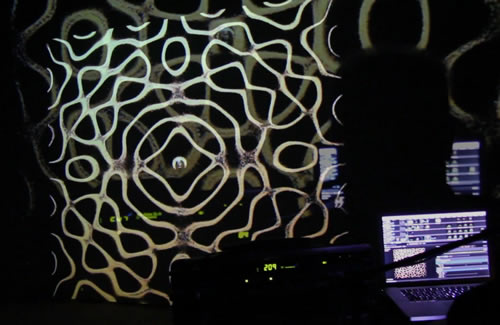

Experiencing Peregrination through a more cognitive filter, one can imagine that the performed piece is its own score; the visual figures could easily become an alternate form of music notation — geometric shapes standing in for their causative frequency. At other times through the performance one is looking at images of individual grains of sand migrating single file across a field of black, soon absorbed into a swirling mass of grains. It can be very difficult to resolve this view without it sliding from microscopic to macroscopic, becoming the movements of our planetary and galaxial clusters, also pushed along by vibrations, though much larger in distance and time. The seasons of millennia that have created landmasses and waterways are reflected in the microscopic flow of sand particles across Joynes’ screen. The movements of our universe, whether the periodicity of a rotating Earth, the revolutions of planet around Sun or the spinning of the Milky Way on its celestial arm, are all vibrational, and act on us, particles, one and all.
Extending his previous work in minimalist electronic composition and combined video and musical performance, Gary James Joynes delves deep into the physical and visual nature of sound. By marrying the generated sound with its consequent visible and physical form, Joynes brings the senses into synch; his performance, Peregrination, is videomusic in pure and minimal form. Knowing the language, one could watch the screen in silence and know exactly what was played, or recreate it visually from the audio track. Where he started by discovering letters in the experiments of Chladni and Jenny, Joynes has invented a new synæsthetic language that he uses to form musical words, pictures, thoughts and ideas.
Installation Works
The following section describes some of Gary James Joynes’ recent works. More information and video documentation of his works can be found on his website. Also see his Vimeo page for information about and videos of other projects and live cinema performances, including excerpts of his first audio-visual performance (MUTEK 2003 at Ex-Centris in Montréal, 28 May 2003).
12 Tones (2011)
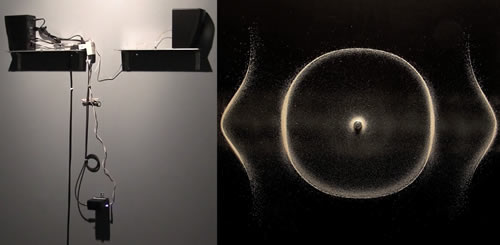

An ever-changing and never repeated soundtrack played live from sculptural wall assemblies fronted by the visual avatars for the individual frequencies creates a room-filling instrument playing an evolving continuous drone work, 12 Tones. Volume modulations based on the movements of viewers within the room, the nature of 12 single channels playing within that room and the harmonic, dissonant and binaural beating patterns of the 12 carefully chosen tones give a unique experience to each visitor. A sound environment characterized by continuous, subtle changes is countered by high-resolution still photographs of the 12 notes in their physical iteration — apropos, as the notes are unchanging in spite of what our brains interpret.
Wavedrifting No. 1 (2011)
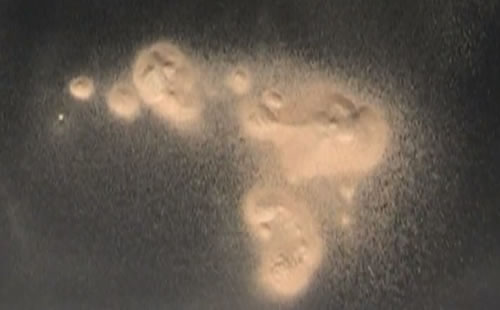

A single-channel video document of the nature of particles bombarded by both composed sound vibration and the resonant vibration of the plate on which they sit, Wavedrifting No. 1 is short film piece that explores the lives of individuals within the greater whole, and the nature of sound and violence in mediating movement within time and space.
Ouroboros (2011)


Composed for the Koffler Institute in Toronto, Ouroboros explores the nature of sound and form within spirituality. Noting the very complex mandala forms created by higher frequency tones, Gary James Joynes created a video projection of five such tones coming into being from, and dissolving back into, a bed of chaos from which the next tone arises. This single-channel projection onto a sculpted bed of sand on the gallery floor is enlivened by a sound environment of the tonal progression in concert with layers of vocal chant and overtone singing (performed by Joynes) that plays, along with the video, in an eternal song cycle. Meditative sounds accompany meditative forms reminiscent of walking meditation gardens and sand mandalas in a consideration of infinite.
Soundbursting No. 1 (2012)
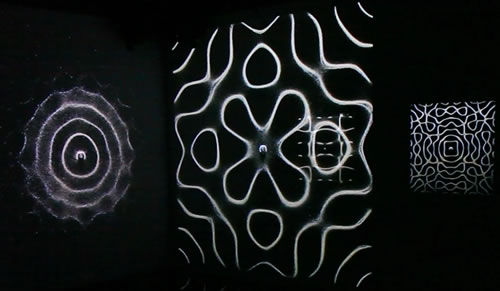

Individual frequencies burst into being both acoustically and visually in Soundbursting No. 1, a 2-channel video (4-channel audio) installation piece in two parts, each of different durations. This evolving composition explores the language of visual sound using the generation of the sound itself as a compositional element as the tones audibly and perpetually interact with each other in the space and then decay, pairing the acoustic and the visual as an attempt at programming synæsthetic understanding. In the artist’s words: “What if we could SEE the moment a sound is created? Imagine this sound moving outward from its source and playing with other sounds… what would we see?”
Tritone (2013)
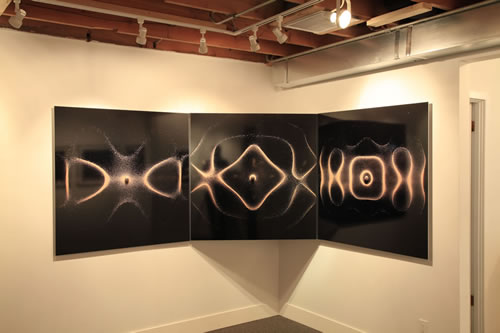
A triptych of visual tones hangs in a corner space while their acoustic counterparts warble in an evolving harmonic conversation whereby the powered speakers are linked with sonar circuits triggering changes in volume of the three notes randomly. The soundtrack for Tritone ran as a continuous 60-day volume decay echoing the final visual-chord played at the premiere of his live cinema performance work Peregrination at the opening night of the 2013 Alberta Biennial of Contemporary Art. This work ran for the entire three-month duration of the Alberta Biennial and was recorded in its entirety to be presented again with the sculpture as the end chord of a long silenced performance.
Social top